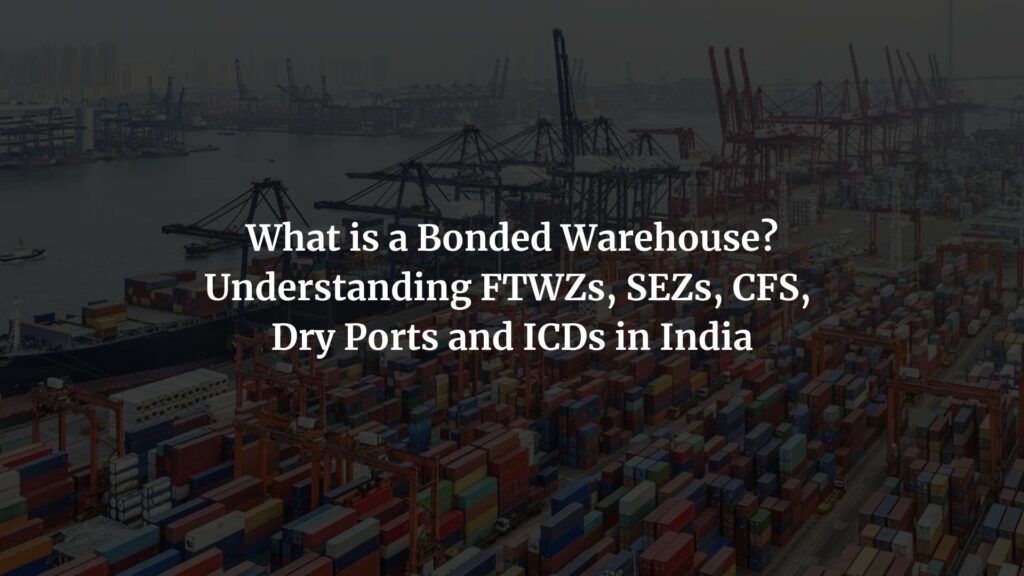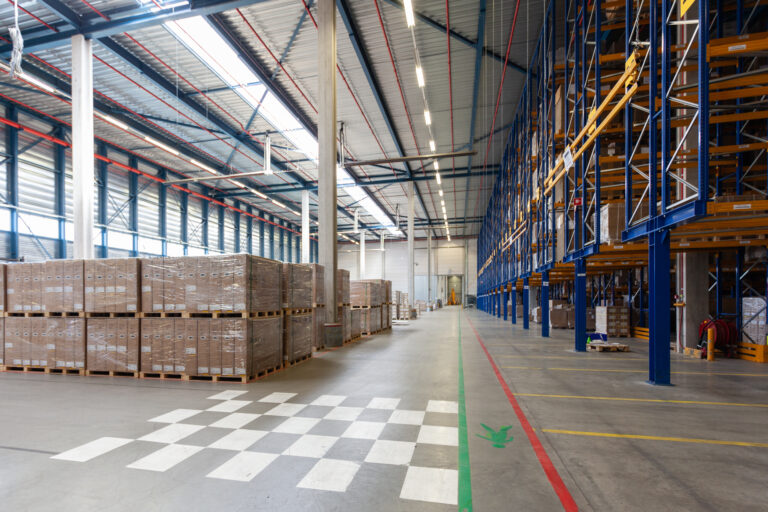our blog
What is a Bonded Warehouse? Understanding FTWZs, SEZs, CFS, Dry Ports and ICDs in India
- rightspaces
- Est.Time - 5 mins
In the world of international trade and logistics, warehousing is far more than just a space to store goods. It is a vital component of a business’s supply chain strategy—impacting everything from working capital to customs compliance and delivery timelines.
India, as an emerging manufacturing and export powerhouse, has developed a diverse warehousing infrastructure to support the movement and storage of goods. Among these are bonded warehouses, Free Trade Warehousing Zones (FTWZs), Special Economic Zones (SEZs), Inland Container Depots (ICDs), Container Freight Stations (CFSs), and dry ports. Each serves a specific purpose within the country’s trade ecosystem.

Bonded Warehouses: A Gateway for Trade Efficiency
A bonded warehouse is a secure facility licensed by Indian Customs where imported goods can be stored without paying import duties and taxes upfront. Duties are levied only when the goods are cleared for domestic consumption. If the goods are re-exported, no duty is payable at all.
This model significantly reduces the financial burden on importers by allowing them to defer duty payments until the goods are actually needed. Bonded warehouses are especially useful for businesses involved in high-value imports, seasonal goods, or re-exports.
In India, there are both public and private bonded warehouses. Public facilities serve multiple users, while private ones are operated by individual companies for exclusive use. These warehouses may also be permitted to carry out light value-added services such as sorting, labelling, or repacking—based on customs approval. For businesses looking for a compliant, duty-efficient import solution, a bonded storage warehouse can offer both flexibility and control.
FTZ vs. FTWZ: Understanding the Difference
While often used interchangeably, Free Trade Zones (FTZs) and Free Trade Warehousing Zones (FTWZs) serve different functions within India’s trade infrastructure.
An FTZ is a broad concept that refers to a designated area within a country where goods can be imported, manufactured, processed, and exported without the usual customs duties and regulations. These zones typically support large-scale manufacturing and export operations.
An FTWZ, on the other hand, is a specific type of FTZ, often considered a specialized subset of a Special Economic Zone (SEZ). FTWZs are designed for warehousing, storage, and value-added services like packing and labeling, specifically to facilitate international trade and re-export. These zones allow businesses to import goods and store them duty-free while enabling operational activities such as packaging, kitting, barcoding, inspection, and light assembly. What makes FTWZs unique is their ability to function as international consolidation and distribution hubs, supporting multi-country sourcing and streamlined logistics for global supply chains.
How FTWZs Function in India
FTWZs in India operate under the Special Economic Zones Act, 2005, and are governed by the SEZ Rules, 2006. From a customs perspective, goods brought into an FTWZ are considered to be outside Indian territory. As such, companies can import and store goods without paying duties unless and until those goods are moved into the Indian domestic tariff area.
Businesses can keep goods in an FTWZ for extended durations without any duty payment and carry out various permitted activities. Goods can either be exported to other countries without incurring Indian customs duties or cleared into the Indian market with duties paid at the time of clearance. Foreign companies can set up units in FTWZs with 100% Foreign Direct Investment (FDI) under the automatic route, making these zones a strategic option for regional inventory and distribution management.
Real-world Example: J. Matadee Free Trade Zone, Tamil Nadu
A strong example of an FTWZ in action is J. Matadee Free Trade Zone Private Limited, located in Sriperumbudur Taluk, Kancheepuram District, Tamil Nadu.
Zone highlights:
- Area: 40 hectares
- Location: Close to Chennai port
- Services: Warehousing, duty-free storage, packaging, kitting
- Ideal for: Importers, exporters, 3PL providers
The facility helps companies streamline international supply chains by offering bonded storage warehouse solutions within a duty-exempt environment.
SEZs: The Broader Ecosystem
While FTWZs are a specialized subset, the broader network of Special Economic Zones (SEZs) in India supports a wide range of economic activities including manufacturing, services, and exports. SEZs offer a range of incentives to promote investment, such as exemption from customs duties, streamlined approvals, and dedicated export infrastructure.
Tamil Nadu leads the country in the number of operational SEZs, with 54 active zones.
One of the most established SEZs in the state is the Madras Export Processing Zone (MEPZ).
MEPZ SEZ – Key Facts:
- Location: Tambaram, Chennai
- Area: 262 acres
- Function: Multi-product SEZ
- Established: Began as an Export Processing Zone in 1984, converted into SEZ in 2003
- Facilities:
- Developed plots and built-up factory spaces
- Offshore banking units
- Container freight station
- Companies Present: Cognizant Technology Solutions, CSC, HTC Global Services
- Employment: Over 26,000 people
Other major SEZs near Chennai include:
- Mahindra World City – a multi-sector SEZ near Chengalpattu
- Sri City SEZ – located in Andhra Pradesh, close to the Tamil Nadu border, housing global manufacturers in electronics, FMCG, and logistics
ICDs, CFSs, and Dry Ports: Connecting the Inland to the Ports
To facilitate trade from non-coastal regions, India has developed a network of Inland Container Depots (ICDs) and Container Freight Stations (CFSs).
ICDs, also known as dry ports, are customs-notified inland facilities offering services such as container stuffing, customs clearance, storage, and transport linkages. They play a key role in reducing port congestion and bringing port-like services closer to inland business hubs. Notable examples include ICDs in Tughlakabad (Delhi) and Whitefield (Bengaluru).
CFSs, by contrast, are usually located near major ports. They assist in consolidating export cargo, deconsolidating imports, and facilitating customs processes for containerized shipments. While the terms are sometimes used interchangeably, a dry port typically refers to an ICD, offering complete port-based functions away from the coast.
Why All This Matters
With India’s growing emphasis on manufacturing, exports, and logistics modernization, understanding the role of facilities like bonded warehouses, FTWZs, and SEZs is crucial for any business involved in cross-border trade. These specialized zones help reduce costs, simplify customs procedures, and enable faster, compliant trade execution.
Meanwhile, ICDs and CFSs provide critical connectivity to ports for businesses located inland, ensuring that no matter where operations are based, companies can efficiently access global markets.
Whether you’re a global brand entering India, an SME managing seasonal demand, or a logistics partner supporting multiple clients, leveraging the right warehousing infrastructure—be it a bonded warehouse or a bonded storage warehouse—can unlock both operational and financial efficiency.
As India continues its journey to become a global supply chain hub, these components—bonded warehouses, FTWZs, SEZs, ICDs, CFSs, and dry ports—will shape the next phase of growth in industrial and logistics infrastructure
Looking for a bonded warehouse? Partner with our expert team, backed by 20 years of experience, and leverage real-time data to make the right choice with Rightspaces. Call us at 98417 23029 / 99404 50950.
Recommended Articles

About the contributor
Anjanakshi is an architect and a valued team member at Rightspaces. With a passion for design and branding, she stays curious, loves reading, writing, and keeping up with market insights in the industrial real estate space.






